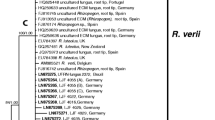Abstract
Two pure Alnus acuminata stands established in a montane forest in central Mexico (Puebla State) were monitored between 2010 and 2013 to confirm and recognize the ectomycorrhizal (EcM) systems of A. acuminata with Lactarius cuspidoaurantiacus and Lactarius herrerae, two recently described species. Through comparison of internal transcribed spacer (ITS) of nuclear ribosomal DNA sequences from basidiomes and ectomycorrhizas sampled in the forest stands, we confirmed their ectomycorrhizal association. The phytobiont was corroborated by comparing ITS sequences obtained from EcM root tips and leaves collected in the study site and from other sequences of A. acuminata available in Genbank. Detailed morphological and anatomical descriptions of the ectomycorrhizal systems are presented and complemented with photographs.





Similar content being viewed by others
References
Agerer R (1987–2002) Colour atlas of ectomycorrhizae. Vol. 1–12 del. Einhorn-Verlag + Druck GmbH, Munich
Agerer R (2001) Exploration types of ectomycorrhizae a proposal to classify ectomycorrhizal mycelial systems according to their patterns of differentiation and putative ecological importance. Mycorrhiza 11:107–114
Agerer R (2006) Fungal relationships and structural identity of their ectomycorrhizae. Mycol Prog 5:67–107
Agerer R, Rambold G (2004–2014) [first posted on 2004-06-01; most recent update: 2011-01-10]. DEEMY – an information system for characterization and determination of Ectomycorrhizae. www.deemy.de – München, Germany
Becerra A, Daniele G, Domínguez L, Nouhra E, Horton T (2002) Ectomycorrhizae between Alnus acuminata H.B.K. and Naucoria escharoides (Fr.:Fr.) Kummer from Argentina. Mycorrhiza 12:61–66
Becerra A, Beenken L, Pritsch K, Daniele G, Schloter M, Agerer R (2005a) Anatomical and molecular characterization of Lactarius aff. omphaliformis, Russula alnijorullensis and Cortinarius tucumanensis ectomycorrhizae on Alnus acuminata. Mycologia 97:1047–1057
Becerra A, Nouhra E, Daniele G, Domínguez L, McKay D (2005b) Ectomycorrhizas of Cortinarius helodes and Gyrodon monticola with Alnus acuminata from Argentina. Mycorrhiza 15:7–15
Brunner I, Brunner F, Laursen GA (1992) Characterization and comparison of macrofungal communities in an Alnus tenuifolia and an Alnus crispa forest in Alaska. Can J Bot 70:1247–1258
Carranza-González E, Madrigal-Sánchez X (1995) Betulaceae. Flora del Bajío y de Regiones Adyacentes 39:1–22
Comandini O, Erös-Honti Z, Jackus E, Flores R, Leonardi M, Rinaldi A (2012) Molecular and morpho-anatomical description of mycorrhizas of Lactarius rimosellus on Quercus sp., with ethnomycological notes on Lactarius in Guatemala. Mycorrhiza 22:279–287
Eberhardt U (2002) Molecular kinship analyses of the agaricoid Russulaceae: correspondence with mycorrhizal anatomy and sporocarp features in the genus Russula. Mycol Prog 1:201–223
Forest F, Savolainen V, Chase MW, Lupia R, Bruneau A, Crane PR (2005) Teasing apart molecular-versus fossil-based error estimates when dating phylogenetic trees: a case study in the birch family (Betulaceae). Syst Bot 30:118–133
Froidevaux L (1973) The ectomycorrhizal association, Alnus rubra and Lactarius obscuratus. Can J For Res 3:601–603
Garay SE, Bandala VM, Montoya L (2012) Morphological and molecular identification of the ectomycorrhizal association of Lactarius fumosibrunneus and Fagus grandifolia var. mexicana trees in eastern Mexico. Mycorrhiza 22:583–588
Gardes M, Bruns D (1993) ITS primers with enhanced specifity for basidiomycetes application to the identification of mycorrhizae and rusts. Mol Ecol 2:113–118
Garibay-Orijel R, Morales-Marañon E, Domínguez-Gutiérrez M, Flores-García A (2013) Caracterización morfológica y genética de las ectomicorrizas formadas entre Pinus montezumae y los hongos presentes en los bancos de esporas en la Faja Volcánica Transmexicana. Rev Mex Biodivers 84:153–169
Geml J, Laursen GA, Timling I, mcFarland JM, Booth MG, Lennon N, Nusbaum C, Taylor L (2009) Molecular phylogenetic biodiversity assessment of arctic and boreal Ectomycorrhizal Lactarius Pers. (Russulales; Basidiomycota) in Alaska, based on soil and sporocarp DNA. Mol Ecol 18:2213–2227
Haug I, Weiß M, Homeier J, Oberwinkler F, Kottke I (2005) Russulaceae and Thelephoraceae form ectomycorrhizas with members of the Nyctaginaceae (Caryophyllales) in the tropical mountain rain forest of southern Ecuador. New Phytol 165:923–936
Henkel TW (2003) Monodominance in the ectomycorrhizal Dicymbe corymbosa (Caesalpiniaceae) from Guyana. J Trop Ecol 19:417–437
Henkel TW, Terborgh J, Vilgalys RJ (2002) Ectomycorrhizal fungi and their leguminous hosts in the Pakaraima Mountains of Guyana. Mycol Res 106:515–531
Henkel TW, James TY, Miller SL, Aime MC, Miller OK Jr (2006) The mycorrhizal status of Pseudotulostoma volvata (Elaphomycetaceae, Eurotiales, Ascomycota). New Phytol 172:753–762
Idzerda S, Noordeloos M (1997) Studies in Lactarius sect. Tabidi. Österr Z Pilzk 6:71–89
Hopple J, Vilgalys R (1999) Phylogenetic relationships in the mushroom genus Coprinus and dark-spored allies based on sequence data from the nuclear gene coding for the large ribosomal subunit RNA: divergent domains, outgroups and monophyly. Mol Phylogenet Evol 13:1–19
Kennedy PG, Garibay-Orijel R, Logan MH, Ángeles-Arguiz R (2011) Ectomycorrhizal fungi in Mexican Alnus forests support the host co-migration hypothesis and continental-scale patterns in phylogeography. Mycorrhiza 21:559–568
Kress WJ, Erickson DL (2007) A two-locus global DNA barcode for land plants: The coding rbcL gene complements the non-coding trnH-psbA spacer region. PLoS ONE 2:e508. doi:10.1371/journal.pone.0000508
Lamus V, Montoya L, Aguilar CJ, Bandala VM, Ramos D (2012) Ectomycorrhizal association of three Lactarius species with Carpinus and Quercus trees in a Mexican montane cloud forest. Mycologia 104:1261–1266
Leonard P (2008) Synoptic keys to British species of Lactarius. British Mycological Society Keys.
Miller SI, Koo CD, Molina R (1991) Characterization of red alder ectomycorrhizae: a preface to monitoring below ground ecological responses. Can J Bot 69:516–531
Miller SI, Koo CD, Molina R (1992) Early colonization of red alder and Douglas fir by ectomycorrhizal fungi and Frankia in soils from the Oregon coast range. Mycorrhiza 2:53–61
Molina R (1981) Ectomycorrhizal specificity in the genus Alnus. Can J Bot 59:325–334
Montoya L, Bandala VM, Garay E (2014) Two new species of Lactarius associated with Alnus acuminata subsp. arguta in Mexico. Mycologia 106:949–962
Montoya L, Haug I, Bandala VM (2010) Two Lactarius species associated with a relict Fagus grandifolia var. mexicana population in a Mexican montane cloud forest. Mycologia 102:153–162
Morris MH, Pérez-Pérez MA, Smith ME, Bledsoe CS (2008) Multiple species of ectomycorrhizal fungi are frequently detected on individual oak root tips in a tropical cloud forest. Mycorrhiza 18:375–383
Morris MH, Pérez-Pérez MA, Smith ME, Bledsoe CS (2009) Infuence of host species on ectomycorrhizal communities associated with two co-occurring oaks (Quercus spp.) in a tropical cloud forest. FEMS Microbiol Ecol 69:274–287
Morrone JJ (2005) Toward a synthesis of Mexican biogeography. Rev Mex Biodivers 76:207–252
Moyersoen B (2006) Pakaraimaea dipterocarpacea is ectomycorrhizal, indicating an ancient Gondwanaland origin for the ectomycorrhizal habit in Dipterocarpaceae. New Phytol 172:753–762
Peay K, Kennedy PG, Brunns TD (2011) Rethinking ectomycorrhizal succession: are root density and hyphal exploration types drivers of spatial and temporal zonation? Fungal Ecol 4:233–240
Polme S, Bahram M, Yamanaka T, Nara K, Cheng Y, Grebenc T, Kraigher H, Toivonen M, Wang PH, Matsuda Y, Naadel T, Kennedy PG, Koljalg U, Tedersoo L (2013) Biogeography of ectomycorrhizal fungi associated with alders (Alnus spp.) in relation to biotic and abiotic variables at the global Scale. New Phytol 198:1239–1249
Pritsch K, Becerra A, Tedersoo L, Schloter M, Agerer R (2010) Description and identification of Alnus acuminata ectomycorrhizae from Argentinean alder stands. Mycologia 102:1263–1273
Pritsch K, Munch JC, Buscot F (1997) Morphological and anatomical characterization of black alder Alnus glutinosa (L.) Gaertn. Ectomycorrhizas. Mycorrhiza 7:201–216
Reverchon F, Ortega-Larrocea MP, Pérez-Moreno J (2014) Structure and diversity of ectomycorrhizal resistant propagules in Pinus montezumae neotropical forests and implications for seedling establishment. Mycoscience 30:1–10
Rochet J, Moreau PA, Manzi S, Gardes M (2011) Comparative phylogenies and host specialization in the alder ectomycorrhizal fungi Alnicola, Alpova and Lactarius (Basidiomycota) in Europe. Evol Biol 11:1471–2148
Ronquist F, Huelsenbeck JP (2003) MRBAYES 3: Bayesian phylogenetic inference under mixed models. Bioinformatics 19:1572–1574
Roy M, Rochet J, Manzi S, Jargeat P, Gryta H, Moreau PA, Gardes M (2013) What determines Alnus-associated ectomycorrhizal community diversity and specificity? A comparison of host and habitat effects at a regional scale. New Phytol 198:1228–1238
Smith ME, Henkel T, Aime MC, Fremier A, Vilgalys R (2011) Ectomycorrhizal fungal diversity and community structure on three co-occurring leguminous canopy tree species in a Neotropical rainforest. New Phytol 192:699–712
Smith ME, Henkel T, Uehling JK, Fremier A, Clarke D, Vilgalys R (2013) The ectomycorrhizal fungal community in a Neotropical forest dominated by endemic dipterocarp Pakaraimea dipterocarpacea. PLoS ONE 8:e55160. doi:10.1371/journal.pone.0055160
Smith ME, Pfister DH (2009) Tuberculate ectomycorrhizae of angiosperms: the interaction between Boletus rubropunctus (Boletaceae) and Quercus species (Fagaceae) in the United States and Mexico. Am J Bot 96:1665–1675
Tamura K, Stecher G, Peterson D, Filipski A, Kumar S (2013) MEGA6: Molecular Evolutionary Genetics Analysis Version 6.0. Mol Biol Evol 30:2725–2729
Tatusova TA, Madden TL (1999) BLAST 2 SEQUENCES, a new tool for comparing protein and nucleotide sequences. FEMS Microbiol Lett 174:247–250
Tedersoo L, Sadam A, Zambrano M, Valencia R, Bahram M (2009a) Low diversity and high host preference of ectomycorrhizal fungi in Western Amazonia, a neotropical biodiversity hotspot. ISME J 4:465–471
Tedersoo L, Smith ME (2013) Lineages of ectomycorrhizal fungi revisited: Foraging strategies and novel lineages revealed by sequences from belowground. Fungal Biol (Rev) 27:83–99
Tedersoo L, Suvi T, Jairus T, Ostonen I, Põlme S (2009b) Revisiting ectomycorrhizal fungi of the genus Alnus: differential host specificity, diversity and determinants of the fungal community. New Phytol 182:727–735
Treu R (1990) Lactarius alpinus. In: Agerer R (ed) Colour Atlas of Ectomycorrhizae, plate 40. Einhorn-Verlag, Schwäbisch Gmünd
Valdés M, Pereda V, Ramírez P, Valenzuela R, Pineda RM (2009) The ectomycorrhizal community in a Pinus oaxacana forest under different silvicultural treatment. J Trop For Sci 21:88–97
Verma RK, Raidl S (2008) Lactarius lilacinus. In: Agerer R (ed) Colour atlas of ectomycorrhizae. Plate 203. Einhorn-Verlag, Schwäbisch Gmünd
Wiedmer E, Senn-Irlet B (2004) Lactarius lepidotus Smith & Hesler + Alnus viridis (Chaix) DC. In: Agerer R (ed) Colour atlas of ectomycorrhizae. Descr Ectomyc 7/8:45–48
White TJ, Bruns T, Lee S, Taylor J (1990) Amplification and direct sequencing of fungal ribosomal RNA genes for phylogenetics. In: Innis MA, Gelfand DH, Sninsky JJ, White TJ (eds) PCR protocols: a guide to methods and applications. Academic Press, New York, pp 315–322
Acknowledgments
We appreciate the assistance in the field and in the laboratory by Bióls. D. Ramos and J.C. Corona (both at Instituto de Ecología, A.C.). Also, we recognize the help of Dr. A. Ramos (postdoctoral at Bandala and Montoya Lab) and Dra. B. Pérez Hernández (at Presequencing Laboratory, Biodiversity and Systematics Net, Instituto de Ecología, A.C.) for their aid in some molecular procedures. We are especially indebted to Dr. E. Ruíz for the important suggestions during the molecular procedures and to Dr. S. Zamudio, for his valuable help in the taxonomic identification of the Alnus tree (both from Instituto de Ecología, A.C., Centro Regional del Bajío). We thank Dr. R. Molina and referees for the careful revision of the manuscript and for their constructive suggestions that enhanced the revised version. We recognize the support given by CONACYT (225382) to the Pre-Sequencing Laboratory, net Biodiversidad and Systematics, INECOL, which facilitated our work during the molecular procedures.
Author information
Authors and Affiliations
Corresponding author
Rights and permissions
About this article
Cite this article
Montoya, L., Bandala, V.M. & Garay-Serrano, E. The ectomycorrhizas of Lactarius cuspidoaurantiacus and Lactarius herrerae associated with Alnus acuminata in Central Mexico. Mycorrhiza 25, 457–467 (2015). https://doi.org/10.1007/s00572-015-0625-8
Received:
Accepted:
Published:
Issue Date:
DOI: https://doi.org/10.1007/s00572-015-0625-8




